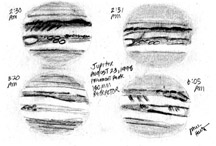Galileo published his observations in Sidereus Nuncius in March 1610: “On the 7th day of January in the present year, 1610, in the first hour of the following night, when I was viewing the constellations of the heavons through a telescope, the planet Jupiter presented itself to my view, and as I had prepared for myself a very excellent instrument, I noticed a circumstance which I had never been able to notice before, namely that three little stars, small but very bright, were near the planet…When on January 8th, led by some fatality, I turned again to look at the same part of the heavens, I found a very different state of things, for there were three little stars all west of Jupiter, and nearer together than on the previous night.”
“I therefore concluded, and decided unhesitatingly, that there are three stars in the heavens moving about Jupiter, as Venus and Mercury around the Sun; which was at length established as clear as daylight by numerous other subsequent observations. These observations also established that there are not only three, but four, erratic sidereal bodies performing their revolutions around Jupiter.”
Every amateur or accidental astronomer who first views Jupiter and its lineup of moons, is amazed at the view. Galileo’s 1610 discovery of these four moons orbiting Jupiter changed history. Looking at the Jovian moons through a small telescope, while trying to imagine Galileo’s first observations, takes my breath away!
A page from Sidereus Nuncius: 1610
First page of my observing log: 1989
My first sketches of the rotation of the four Galilean satellites: 1989


